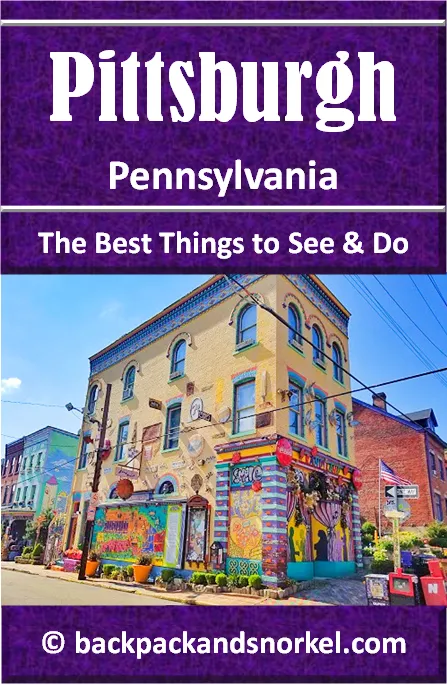SELF-GUIDED WALKING TOUR OF PITTSBURGH'S GOLDEN TRIANGLE (PART 4) - Pittsburgh Purple Travel Guide
This is Part 4 of our self-guided walking tour of Pittsburgh's Golden Triangle, which covers the highlights of Pittsburgh's architecture, history and culture.
The information on this webiste and much more: google maps locations, reviews and attraction websites can be found in the Pittsburgh Travel Guide that you can preview and purchase at the Backpack and Snorkel Travel Store.
Go to the beginning of the tour here.
31. U.S. STEEL TOWER
Now go back to Sixth Ave and make a left until you get back to Grant St. You will see the U.S. Steel Tower across Grant St to your left.
Don’t cross Grant St yet. Walk left until you pass First Lutheran Church and come to Strawberry Way. Take a peek at Strawberry Way with its beautifully painted pavement. Now you can cross Grant St.
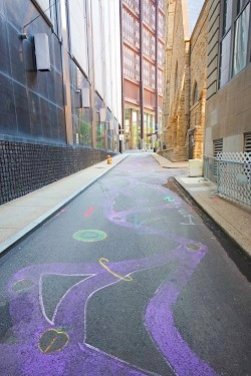
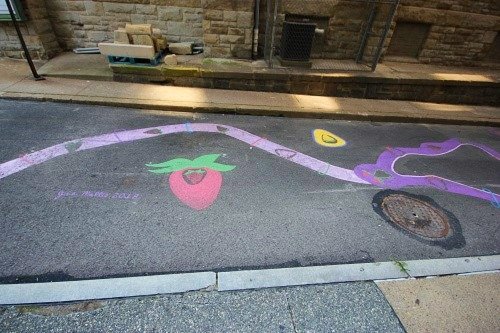
The U.S. Steel Tower, also known as the USX Tower, opened in 1971 and is the tallest building in Pittsburgh. At 841ft (256m) height, this 64 story skyscraper is the fifth tallest building in Pennsylvania, the 52nd tallest in the US and the 200th tallest in the world. It is, however, the tallest building in the world with a completely flat roof.
More than 40,000 metric tons of structural steel were used in the construction of the building.
The tower is notable for:
- its triangular shape with indented corners
- being the first building that used liquid-filled fireproofed columns
- the steel columns on the exterior of the building were made of a specially developed steel that was produced in the U.S. Steel Homestead Works and is weather resistant. Slowly over the first years of weather exposure, the steel surface formed a dark brown oxidized layer, which protects the underlying steel and thus does not require costly painting or rust removal. The initial weathering of the material resulted in a brownish runoff that colored the sidewalks around the USX Tower and nearby buildings rust brown. USX cleaned up much of the mess, but you can still see rust spots on some of the sidewalks and the street signs in front of the building.
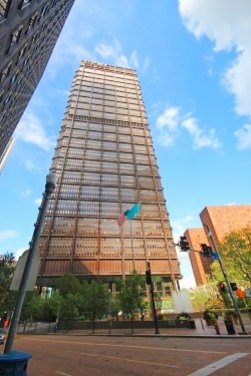
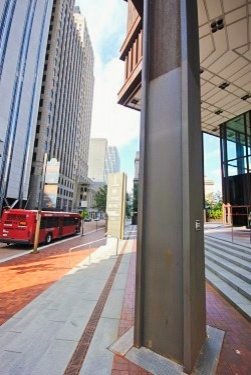
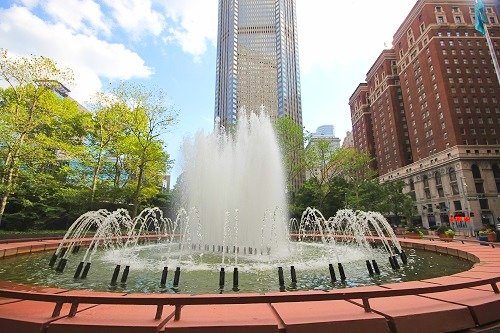
32. GULF TOWER
Cross Seventh Ave and Grant St and you stand in front of Gulf Tower.
Gulf Tower was completed in 1932 as the headquarters of the Gulf Oil Company. Gulf Oil Corporation was one of the largest multinational oil companies in the US until its merger with Chevron in 1984, which was the world's largest merger at that time.
The 44 story, 177m (582ft), Art Deco skyscraper has a distinct looking crown which is modeled after the Mausoleum of Halicarnassus, an ancient Greek mausoleum in what is now Turkey. It is in the style of a step pyramid. The building was listed as a Pittsburgh History & Landmarks Foundation Historic Landmark in 1973.
On June 13, 1974, a bomb was detonated on the 29th floor by domestic terrorists.
Gulf Tower is one of the most recognizable structures in Pittsburgh’s skyline at night, because of the way the pyramid at the top is illuminated. In collaboration with KDKA, the pyramid is illuminated in different colors according to the weather forecast.
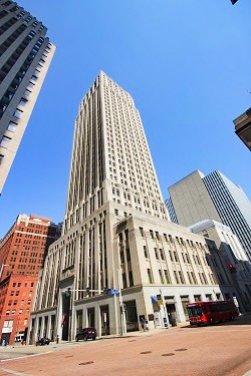
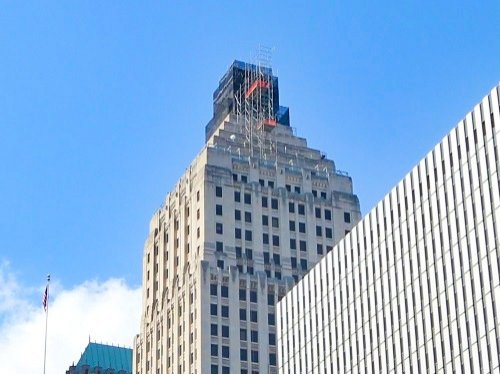
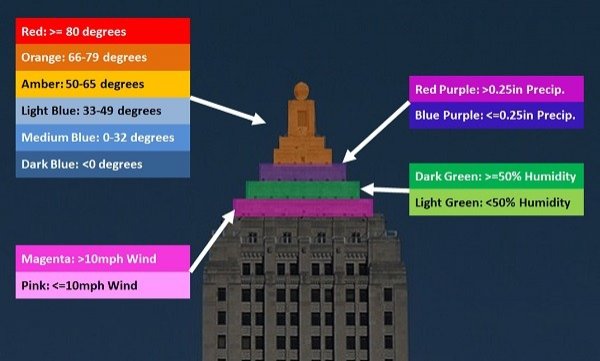
33. FORMER UNION STATION
Keep walking north on Grant St and pass the US Courthouse until you come to the intersection with Liberty Ave.
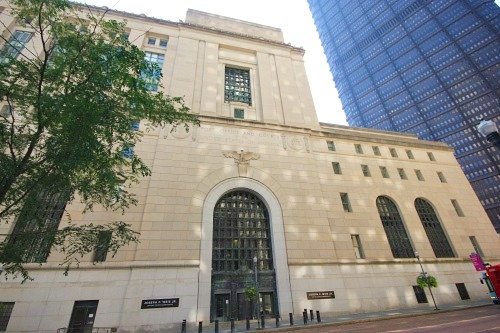
To your right you will see the former Union Station or Penn Station. This is now an apartment building but the Amtrak tracks and station are still there - just a little hidden.
As this is now a privately owned building, you cannot enter it anymore to look at the former grandeur of the train station. But what you can do is to go to the rotunda in front of the main entrance and admire its beauty.
The current building is from 1904 and it replaces the original Union Station building that was destroyed in 1877. In 1986, work was started to convert the building to private apartments and the building opened in 1988 as The Pennsylvanian apartment building.
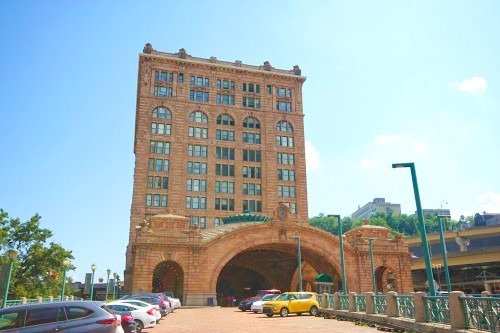
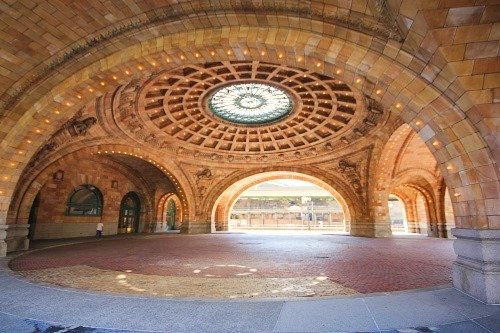
34. DAVID L. LAWRENCE CONVENTION CENTER
Walk west on Liberty Ave which is almost the opposite direction of where you came from and pass by the parking garage with the Greyhound Bus office. At the next corner you will see the Westin hotel to your right and the rounded end of the August Wilson African American Cultural Center.
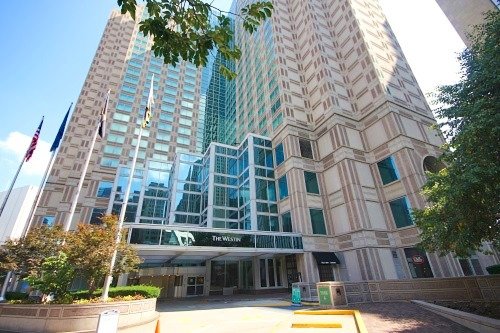
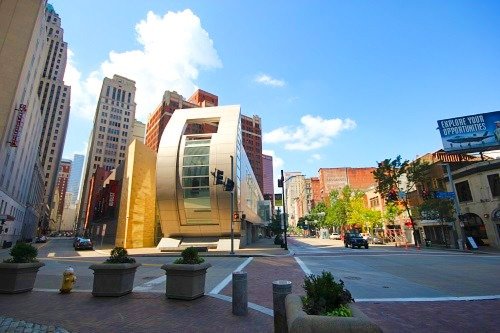
The David L. Lawrence Convention Center is straight ahead two blocks to the north (right). Cross the intersection and you will notice that William Penn Pl. is now Tenth St. Walk one more block towards the convention center until you hit Penn Ave.
The David L. Lawrence Convention Center is a 1.5 million sqft (140,000m2) convention center and the second with this name in this place. The original David L. Lawrence Convention Center opened in 1981 and had a 131,000 sqft (12,000m2) exhibition area. It was demolished and completely rebuilt. The building that you see today opened in 2003. It received LEED-NC Gold certification, was the world’s largest green building in 2003, the first LEED certified convention center and it won the 2004 Supreme Award for structural engineering excellence from the Institution of Structural Engineers.
The convention center is named after David L. Lawrence who was the longest tenured mayor of Pittsburgh (1946–1959), the Democratic Governor of Pennsylvania from 1959 to 1963 and the only mayor of Pittsburgh to be elected Governor of Pennsylvania. He was the main driving force behind Pittsburgh's urban renewal projects which included the Fort Pitt Tunnel, Gateway Center, Mellon Arena, and Point State Park.
There is not much to see and do when there are no events going on in the convention center.
You will now need to make a decision if you want to continue the tour and visit the Senator John Heinz History Center or skip the History Center and continue with an abbreviated tour. To continue with the tour, read on. To do the abbreviated tour, please jump to the Cultural District part and #36 right after the #35. Senator John Heinz History Center part.
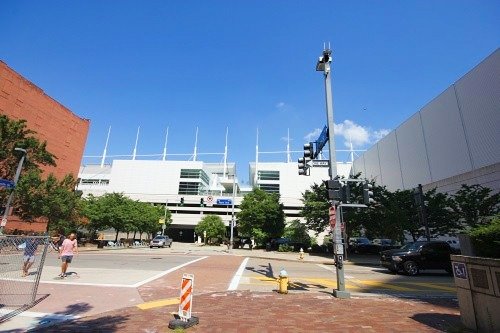
35. SENATOR JOHN HEINZ HISTORY CENTER
We are glad you decided to see the Senator John Heinz History Center as this can be one of the highlights of your Pittsburgh trip if you are interested in the history of Western Pennsylvania.
We assume you are standing at the intersection of Penn Ave and Tenth St and are looking towards the Convention Center. Follow Penn Ave for 2 long blocks to the right (east) and then make a left on 12th St and a right on Smallman St. The entrance to the Senator John Heinz History Center is at the end of this block to your right.
The Heinz History Center is an affiliate of the Smithsonian and Pennsylvania’s largest history museum. There are more than 40,000 artifacts of Western Pennsylvania’s history exhibited on six floors.
Some of the permanent exhibitions are:
- Mister Rogers’ Neighborhood – original set pieces and artifacts
- Pittsburgh: A Tradition of Innovation - 250 years of Pittsburgh innovations
- Heinz – 150 years of the H.J. Heinz Company
- From Slavery to Freedom – 18th century Africa to 21st century Western PA
- Special Collections Gallery – Western PA’s unique blend of cultures and people
- Glass: Shattering Notions – Pittsburgh used to be America's Glass City
- Discovery Place and Kidsburgh – for kids to learn about Pittsburgh history
- Clash of Empires: The British, French & Indian War, 1754-1763
More information about the Senator John Heinz History Center can be found here.
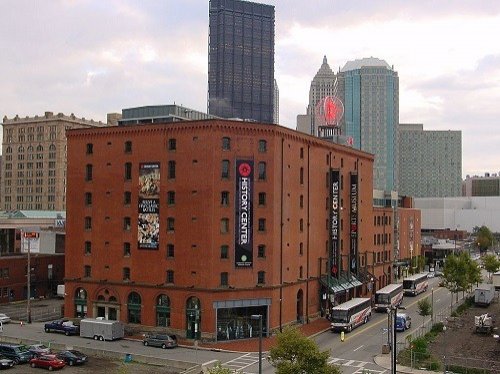
Source: Nakrakosky, resized, the license is here.
CULTURAL DISTRICT
If you are at the Heinz History center, then trace back your steps to the David L. Lawrence Convention Center by going west on Smallman St, then left on 12th St and then right on Penn Ave. After following Penn Ave for two blocks west, you are back at Penn Ave and Tenth St.
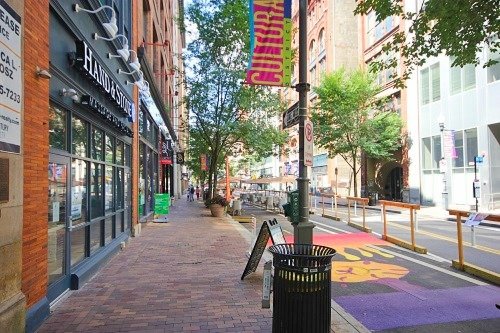
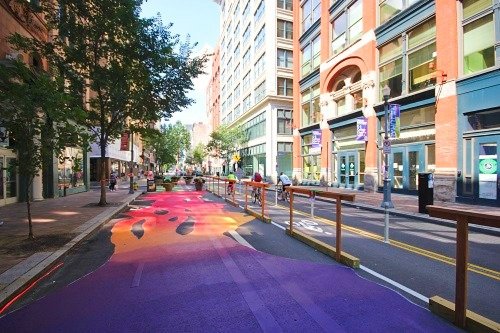
36. CELL PHONE DISCO
From the intersection of Penn Ave and Tenth St, follow Penn Ave to the west for three more blocks and make a left into Tito Way. Tito Way is a narrow street and, if you are unlucky and the Benedum is changing sets between shows, then the street may be packed with cars and trucks and you may not be able to see anything. Normally, you should see various art installations hung on the walls and, in the center of Tito Way, you should see the Cell Phone Disco.
Installed in 2010, the Cell Phone Disco is Pittsburgh’s first interactive outdoor art & science installation. It visualizes the electromagnetic field of an active cell phone on a 16ft x 16ft screen that contains 2,034 individually controlled LED lights.
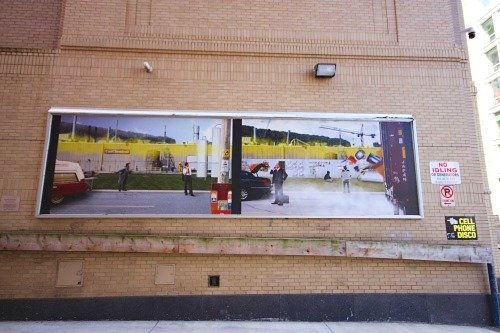
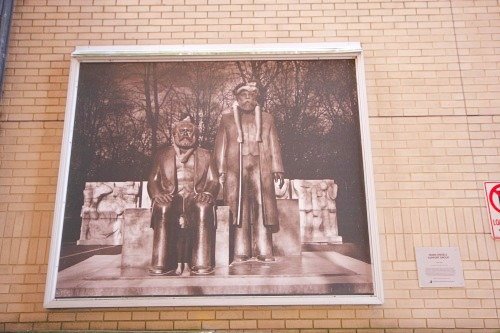
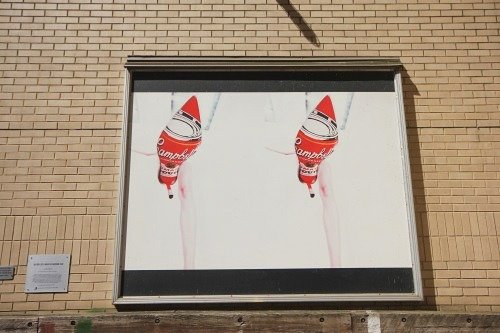
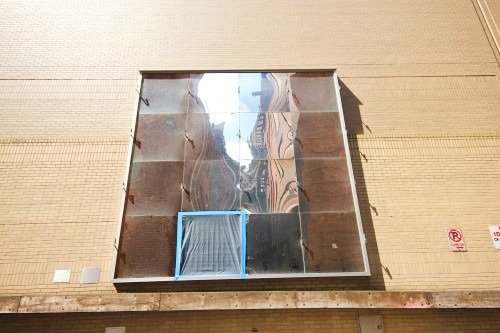
37. BENEDUM CENTER FOR THE PERFORMING ARTS
Walk back to Penn Ave and you will see the Benedum Center for the Performing Arts to your left.
Built in 1928 as the Stanley Theatre, with seating for 3,800 people, this was the largest movie theater in Western Pennsylvania. It was Pittsburgh's main first-run house for all Warner Bros. film releases. Notable entertainers that appeared here are:
- Frank Sinatra in 1943
- Frank Zappa in 1978
- Bob Marley performed his last live concert here in 1980, before his death in 1981
- rince in 1981
- Grateful Dead performed four shows
Billboard named the Stanley Theater "Number One Auditorium in the U.S." several times
A renovation to convert the movie palace into a full performing arts center started in 1984 and lasted until 1987 when the theater reopened as the Benedum Center for the Performing Arts. The interior was largely preserved and, in some cases, restored to its original design.
Today, the Benedum Center is the home of the Pittsburgh Ballet Theatre, Pittsburgh Civic Light Opera and Pittsburgh Opera.
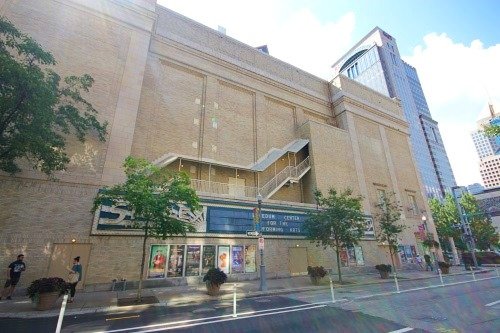
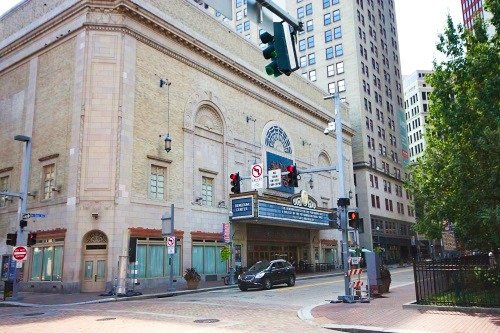
38. 7TH AND PENN PARKLET
Across Penn Ave on its northern side are two small parks to the left and right of Seventh St.
The first and smaller one is on the right hand side of Seventh St. It is called "7th and Penn Parklet".
This small park showcases an art installation called "Magnolias for Pittsburgh". Each of the two bronze hand sculpted magnolia trees contains approx. 800 individually painted petals. The artist said the goal was "to create a little magic, fairy-tale moment in the daily hustle and bustle of Downtown Pittsburgh".
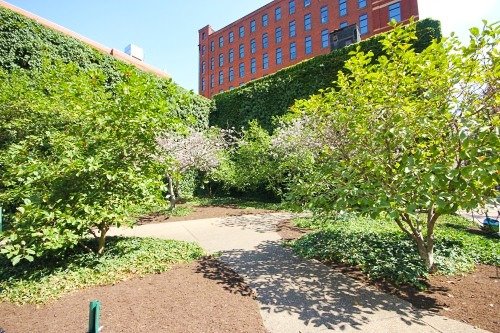
39. AGNES R. KATZ PLAZA
Cross Seventh St and you come Agnes R. Katz Plaza.
Named in honor of local arts supporter Agnes R. Katz, this central feature of the Cultural District is dominated by a 25ft bronze fountain and eyeball-shaped benches. The fountain has two streams of heated water that spout from the top and that allow it to flow all year.
The park also has 32 linden trees that were planted closely together in double rows so that the branches can be woven with each other.
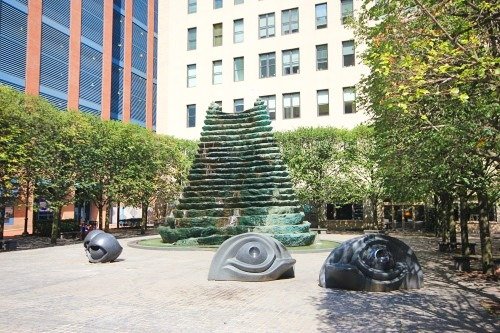
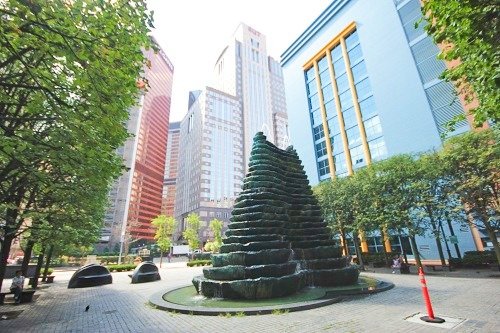
40. THEATER SQUARE
Adjacent to the park on the same side of Penn Ave is Theater Square. The building is blue on one side and orange-brown on the other.
Theater Square is the heart of the Cultural District since 2003 and it houses:
- Centralized box office - one-stop shop for Cultural District tickets
- Greer Cabaret Theater - 253 seats, shows are e.g. Wine Flights, Beer Schools, salsa dancing and improv comedy
- Backstage Bar – featuring late night cabaret, live music, food and specialty drinks
- Parking garage – 790 parking spaces
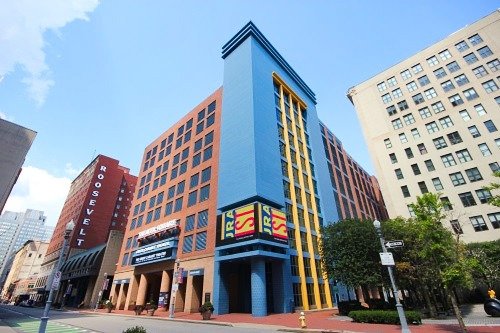
The tour continues here.
Author: Rudy at Backpack and Snorkel
Bio: Owner of Backpack and Snorkel Travel Guides. We create in-depth guides to help you plan unforgettable vacations around the world.
Other popular Purple Travel Guides you may be interested in:
Like this Backpack and Snorkel Purple Travel Guide? Pin these for later:



